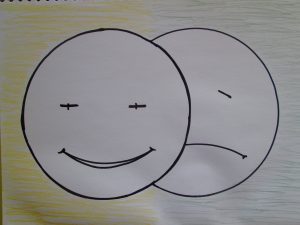The newspaper journalist told me she’d be sending a photographer to my reading the next day, which was scheduled to begin at two at the local museum. I thought no more about it.
So the next afternoon at two, I greeted the attendees, thanked them for coming, and forced a smile to mask my nerves. I told them about my new book, Jamie’s Muse, and why I’d come all the way to Kirriemuir, Scotland, to share passages with them.
Then I began to read, dramatically, from a sad chapter about my great-grandparents’ (who were from Kirriemuir) violent deaths in Natal, South Africa. It was at that point I noticed from the corner of my eye that a man had slipped into the back of the room. He began pacing up and down, pointing a long-lens camera at me, quietly taking photos.
I regret that I didn’t take a moment to look up at him, acknowledge him, and smile.
The next day, when the paper came out, it contained a long article on the American author who’d come all that way to launch her new book. Accompanying the article was a large photo of a very sad and droopy face. Mine.
I hardly recognized myself.
The person I see reflected in the mirror, which I consult as seldom as possible every day, normally tries to smile. It’s an old exercise, stemming from childhood, when my mother frequently admonished me: “Put a smile on your face, Bonnie! Nobody wants to see your long face. Why do you always look so glum? Smile!”
My mother was an expert at this – hiding her true feelings behind a fake smile, the way she hid the bruises on her pretty face behind thick makeup.
She often shared her strongly held beliefs with me: “Never tell anyone about your problems. Nobody gives a damn. If anyone asks ‘How are you?’ just say, ‘Fine.’ And smile.”
But I rebelled against her stance, preferring instead to tell the truth about domestic violence and other cruelties, to whomever cared to pay attention. I credit my mother with – unintentionally, to be sure — launching my career as a truth-telling writer. Life, I’d learned from a very early age and too many years of observation, is not all smiles.
Nevertheless, I’ve also learned, happily, there’s a lot to be said for smiles – genuine smiles, that is, that express true happiness, and are not simply masks for nervousness, sorrow, or pain.
Psychologists have a term for this true smile of happiness. They call it a “Duchenne Smile,” which is characterized by narrowed, happy eyes that leave wrinkles, or “crow’s feet,” in addition to the upturned corners of the mouth, which stereotypically are associated with a smile.
Mexicans, a notably happy people, I’ve observed in the nearly three years I’ve lived in Mexico, are quick to smile genuine smiles. If you study the old folks’ weather-worn faces, you see deeply carved crow’s feet by their eyes. When you pass Mexicans of any age on the sidewalk and you make eye contact, you’re sure to exchange smiles. These are guileless smiles, a-sincere-recognition-of-our-shared-humanity smiles. The kind of smile that brightens your day.
We gringos here in San Miguel de Allende, Mexico, I’m afraid, have a reputation for not smiling. We walk with our heads cast down (no doubt to avoid tripping on the cobblestone streets and wildly uneven sidewalks); we don’t make eye contact (those of us from big American cities like New York know better than to do that); we remain for the most part in our own, old, cultural bubbles and charge ahead, oblivious of others.
A Mexican friend once told me that Mexicans see this behavior as sad. They think we are deeply unhappy people, even, she said, “bitter.” Sad indeed.
In an ongoing effort to bridge the cultural and language divide, I bought a workbook the other day from the Warren Hardy Spanish School here, offering to help me progress in my glacial efforts to learn, as the workbook’s cover states, “authentic Mexican Spanish from the heart of Mexico.”
The first chapter is on “Social Protocol,” stressing the importance of such things as greetings, farewells, and requests. “This is important because Hispanics usually perceive Americans as cold or even rude because we don’t commonly greet each other in our culture,” the book states, adding, “Use the social protocol every day, everywhere. Es muy importante.
“And don’t forget to smile!”

